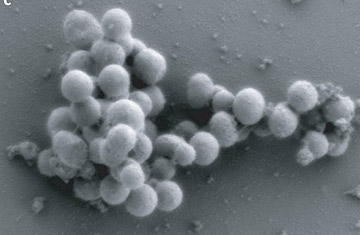
Synthetic M. mycoides genome in yeast.
(2 of 2)
But that was only half the goal. The next step was to insert the man-made genome into a cell and see if it could function properly and cause the cell to divide. "The first transplants we did — we usually do them on a Friday and on Monday morning we come back to see if anything grew — didn't work," Venter says. "Then a month ago, I got a text at six in the morning that we had a colony."
Venter is the first to concede that while what he has created is life, it's not new life, since the synthetic genome is a copy of an existing one, albeit with a few modifications. In order to confirm that the genome they generated was indeed entirely manmade, the scientists inserted some genetic watermarks, including their names and three philosophical quotations. Since the four-based genetic code is read in three-letter triplet combinations, the scientists devised a new code in which the 64 possible triplets symbolize the letters of the alphabet and punctuation. One of the quotes, by James Joyce, was especially apt: "First to live, to err, to fall, to triumph and to create life out of life." Says Venter understatedly: "The chances of finding these sequences in the natural genome are close to zero."
Synthetic biology, as the field of man-made biological components such as Venter's is called, is a promising new field that raises as much concern as it does excitement. It's basically genetic engineering writ on a larger, more profoundly amped-up scale. That process could generate valuable new species that can produce vast amounts of much-needed food or pharmaceutical products, and Venter is already at work on such projects. Collaborating with Novartis, he is building a bank of man-made versions of every known influenza strain so that if a new strain, such as H1N1, begins to circulate during flu season, vaccine makers can simply pull the appropriate synthetic segments off the shelf and begin the vaccine making process, cutting the months-long job of sequencing the appropriate strain down to a single day.
Working with Exxon, Venter's team is investigating ways to harness algae to convert carbon dioxide into a hydrocarbon source for biofuel on a scale that would finally make such alternative energy options worth pursuing. "No natural algae we know would do this on the scale needed," he says. "So we have to use a synthetic genome technique to either heavily modify existing algae or devise whole new ones." And the same strategy can be used to build organisms that can clean up pathogens in water or boost nutritional content in foods such as wheat crops.
Those, of course, are the positive applications, but even Venter acknowledges that the approach can have some less useful, and even dangerous outcomes. The same technique could generate unheard of combinations of genes in the form of potentially dangerous mutants. "Somebody could do something, like copy one of the existing pathogens out there," Venter admits, "but the odds of that are extremely low. This is not a trivial process, and isn't something that labs are going to start repeating at the same scale."
As his team was perfecting the technology, Venter invited the National Academy of Sciences and other U.S. government agencies to review the promise and dangers of synthetic biology to ensure, he says that "the science proceeds in an ethical fashion, and that we are being thoughtful about what we do."
It's a discussion that Venter hopes will continue, as the range of applications for synthetic cells becomes clear. "This whole field was theoretical until this experiment worked," he notes. "This is the early beginning showing all that is now possible."
